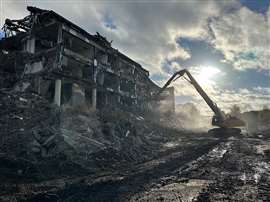Why sorting C&D waste is going to get harder
13 May 2024
Speaking in the most general of terms; when a structure is marked for demolition, it’s usually because it has reached the end of its useful working life and is not suitable for refurbishment.
 The Lilly House complex was only 25 years old when it was demolished. (Photo: HWM Group)
The Lilly House complex was only 25 years old when it was demolished. (Photo: HWM Group)
Ergo, the majority of the buildings that are now being demolished were built around 70 – or more years ago. Thus, they are generally comprised of a limited number of materials: timber, brick, concrete, steel, ceramics, glass.
However, an increasing number of structures - particularly commercial properties, from the 1980s onwards are also now being dismantled.
And these are presenting contractors with a far bigger challenge when it comes to sorting and segregating materials.
Adam Blake, Director of United Kingdom-based HWM Group, says: “The newer the building, the more sorting and segregation you have to do.
“They’re full of styrene, plastic, fibreglass etc. There are just masses of constituents. Whereas, with an older building, it’s mainly just timber, tile and brick.
“The newer stock is not built for the demolition industry,” says Adam. “It’s not built for segregating and sorting.”
According to Adam, this means that structures of this kind require more small machine work. “Basically, you’re disassembling. The newer stock is the result of a more linear economy: it’s take, make, consume, dispose.
“It’s not restorative in nature.”
Energy efficiency Vs circularity
While Adam would agree that minds are turning more towards designing buildings with their end of life being considered from the outset, this is something that is only just starting to happen and is, for the most part, something that is currently only incorporated into large-scale projects.
According to the managing director, the majority of the commercial structures actually being built today, are still being designed more with energy efficiency in mind, rather than circularity.
“All the new buildings are driven by insulation, to be energy efficient. This is not efficient at the end of the building’s life.”
 HWM Group’s demolition of Lilly House Pharmaceuticals. (Photo: HWM Group)
HWM Group’s demolition of Lilly House Pharmaceuticals. (Photo: HWM Group)
Adam says: “We just did a project for Glencar in Basingstoke. We demolished Lilly House Pharmaceuticals.
“I think that the whole project was a £1.2 million (US$1.5 million) demolition scheme. For us it took 22 weeks, and that building was only 20 to 25 years old – if it was 26, I’d be surprised.
“So, it was not old at all. And it was also a massive building… Insulation everywhere.”
Demolishing ‘newer stock’ commercial structures
HWM Group began work on Lilly House complex, which was previously owned by a pharmaceutical company and known as Northumberland House, in late 2022.
The site consisted of four distinct structures that incorporated seven floors; two underground car parking levels and five above ground floors of office space and data centre facilities.
 Limited space on the site made both the demolition works and the sorting of waste materials particularly challenging. (Photo: HWM Group)
Limited space on the site made both the demolition works and the sorting of waste materials particularly challenging. (Photo: HWM Group)
While the structure itself presented its own challenges, including a fair amount of asbestos removal, its location on an industrial site generously provided several more just for good measure.
Several other businesses, a hotel, residential blocks and two main road arteries were all in close proximity. Utility substations and underground power and telecoms networks for the adjacent businesses and a nearby hospital, added further complications.
This meant that HWM Group had to locate, secure and protect these critical infrastructures throughout the demolition and ground stabilisation process.
Money or Time: which costs clients more?
While the soft strip of each of the four Lilly House structures and their demolition to floor slab level went according to plan, with the project – including the crushing and reuse of all arisings and removal of waste streams - completed on time and on budget, Adam points out that sorting and segregating waste is not the only challenge inherent in recycling.
Although most demolition contractors have been prioritising the recycling and reuse of building materials for as long as anyone can remember, a contractor’s ability to recycle waste materials all too often remains subject to the physical size of the jobsite, and the project’s programme constraints.
“We always go for recycled materials, but takes more time and you need the space on site to do it,” says Adam, adding that the readily available status of virgin materials - although more expensive - can often be a more expedient, and therefore attractive, solution for clients.
“As soon as you’ve got the time to process on site and the client is giving you that window of opportunity to do it, then it’s 100% worth doing.”
And for those clients who might prefer the quicker, albeit more pricey, alternative so that the works can stay on schedule, “it’s really about trying to show them the cost benefits”, says Adam.
 Plastic kerbs are among the sustainable products already being used in construction. (Photo: Duraproducts)
Plastic kerbs are among the sustainable products already being used in construction. (Photo: Duraproducts)
Sustainable building products
While it won’t help contractors deal with the huge number of constituent materials of buildings built from the 1980s onwards, the shift to a sustainable, circular economy is driving materials manufacturers to develop products with their end of life in mind.
Andrew Leah, Technical Manager at Duraproducts, says: “As the demand for recycled traditional materials grows, the last 20 years have demonstrated that specifiers are constantly seeking newer and greener materials and a prime example of this is recycled plastic.
That said, Andrew thinks that old beliefs are still a problem.
“The misconception still remains that sustainable products compromise on longevity and durability,” he says.
“However, cellular recycled plastic products used in many developments – including many civil engineering, industrial, and housing projects – have shown exceptional resistance to damage, significantly lowering post-construction repairs.
“This translates to lower carbon emissions, less need for heavy machinery, and ultimately, enhanced project sustainability.”
Of course, how these new, sustainable products will also further impact the sorting process when contractors eventually come to dealing with them on a daily basis, is yet to be seen - and won’t be for some time.
CONNECT WITH THE TEAM









